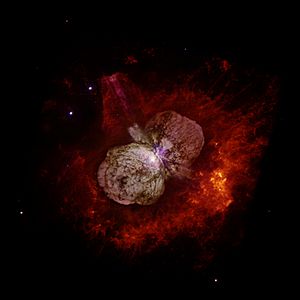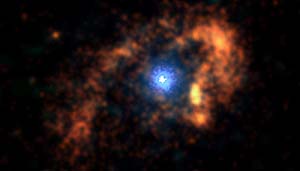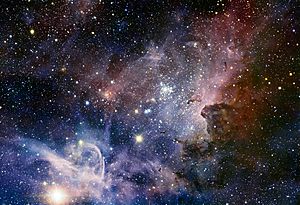Eta Carinae facts for kids


Eta Carinae (also called η Carinae or η Car) is a super bright star system. It is found in the constellation Carina, which is a group of stars that form a pattern in the sky. This amazing star system is about 7,500 to 8,000 light-years away from our Sun.
The Eta Carinae system has at least two stars. The main star is a huge, bright blue star that used to be about 150 times the size of our Sun. It has lost a lot of its material over time. Another hot, giant star, about 30 times the size of our Sun, orbits around it. A thick cloud of gas and dust, called a nebula, surrounds Eta Carinae. This cloud makes it hard to see the second star directly. But scientists know the two stars are there because of the shape of this gas cloud.
The Eta Carinae system is found inside a special cloud called the Homunculus nebula. This nebula is part of an even bigger cloud called the Carina nebula. Together, the stars and nebulae shine brighter than five million Suns! You can't see Eta Carinae if you live north of 30°N latitude (like in most of the USA or Europe). But if you live south of 30°S latitude, you can always see it. Because of its huge size and how old it is, scientists expect Eta Carinae to explode as a supernova in the future.
Contents
How Eta Carinae Changed Over Time
Eta Carinae was first seen as a star that was not very bright. But from 1837 to 1856, it became much brighter in an event called "the Great Eruption." Between March 11 and 14, 1843, Eta Carinae became the second brightest star in the night sky! After that, it faded and became too dim to see with just your eyes.
Since about 1940, it has started to get brighter again. It reached its brightest point in 2014. If you are south of 30°S latitude, Eta Carinae is always visible in the sky.
What Makes This Star System Special?
This star system is one of the biggest and heaviest that scientists can study in detail. For a long time, people thought Eta Carinae was just one huge star. But in 2005, scientists found out it was actually a binary star system, meaning it has two stars orbiting each other. The biggest star in the Eta Carinae system is probably more than 100 times the mass of our Sun!
Stars like Eta Carinae produce over a million times as much light as the Sun. They are very rare. There are only a few dozen of them in a galaxy the size of our Milky Way. These stars are so big and bright that the light they produce almost pushes their own gas away. This is called being near or over the Eddington limit. Stars that are more than 120 times the mass of the Sun are so powerful that their gravity can barely hold onto their own gas and light.
Eta Carinae is very important to scientists because of its giant eruption around 1843. In just a few years, it gave off almost as much visible light as a supernova explosion! But unlike a supernova, the star survived. This event is called a 'supernova impostor' or 'failed supernova'. Eta Carinae's giant eruption was the first example of this type of event that scientists studied.
One amazing thing about Eta Carinae is how its brightness changes. Scientists now call it a luminous blue variable (LBV) binary star. This is because of the strange way it gets brighter and dimmer. The light and energy from the second star in Eta Carinae is the main source of radiation for the system. Much of this energy is taken in by the main star's strong stellar wind, which is like a powerful breeze of particles flowing out from the star.
Related pages
Images for kids
-
Hubble composite of Eta Carinae showing the unusual emission spectrum (near-IR image spectrum from the HST STIS CCD)
-
Animation showing the expanding light echo caused by the Eta Carinae eruption in the Carina Nebula
-
One theory of Eta Carinae's ultimate fate is collapsing to form a black hole—energy released as jets along the axis of rotation forms gamma-ray bursts.
See also
 In Spanish: Eta Carinae para niños
In Spanish: Eta Carinae para niños
















